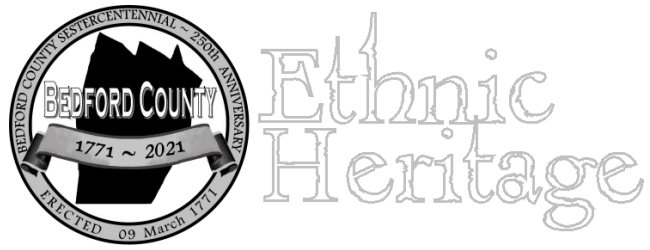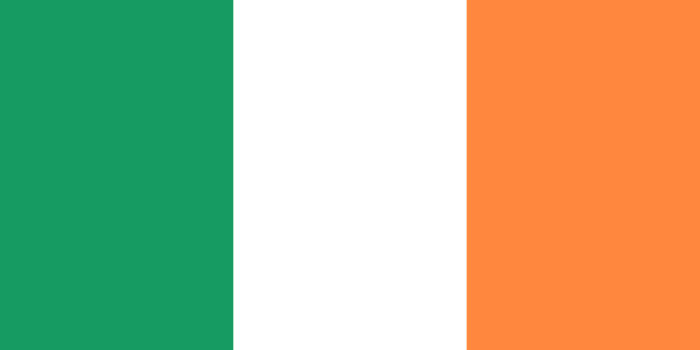
Irish~American Day
17 March 2021

The American Community Survey, compiled between 2008 and 2012 and being the most recent analysis, identified 6% of the total population of Bedford County as descending from Irish ancestors. Many of them came after the American Revolutionary War, with the largest influx being between 1820 and 1930.
According to records maintained in the Archivo General de Indias at Seville, Spain, expenditures for gunpowder at St. Augustine in the year 1600 revealed that gunpowder was used during the festivities to honor San Patricio, or St. Patrick. The festivities included the firing of the city's artillery across the harbor. The day chosen to honor St. Patrick was the 17th of March, which was believed to be the day in the year 461 AD on which he died.
In 1737, the Charitable Irish Society of Boston, taking its cue from traditions brought over from Ireland, organized a worship service and dinner in what was the first observance of St. Patrick's Day in the thirteen British Colonies. Every year thereafter, the people descended from Irish immigrants celebrated with rollicking fervor on the feast day of St. Patrick. Back in Ireland St. Patrick's Day was observed primarily as a solemn religious holyday. In recent decades, though, as Irish culture has been spread around the world, the festivities long held in the United States have found their way back to the land in which the saint actually resided.
In 1991, President George H. W. Bush declared 17 March to be a national holiday. Ever since that year, the Taoiseach, or Prime Minister of Ireland visits the President of the United States for a shamrock-giving ceremony in the Oval Office of the White House.
For celebrations of St. Patrick's Day everything is green, from the simple wearing o' the green to very raucous parties in which green beer is drank and cake with green icing is eaten. Like Oktoberfest to the German~Americans, St. Patrick's Day to the Irish~Americans is a holiday devoted to partying and drinking beer and other alcoholic beverages. In some of the cities in the United States where large populations of Irish immigrants settled, parades on St. Patrick's Day have been the usual entertainment.
St. Patrick's Day celebrants dress in green clothing, but if they don't have anything green to wear they at least wear lapel pins in the shape of four-leaf shamrocks. But what is so significant about wearing green on St. Patricks Day? Leprechauns, of course! Leprechauns are unable to see the color green, so if you are wearing green clothing, you will be invisible to them. [At least that's what children are told.]
The wearing of the color green actually came about through two political events. In 1641 the Great Irish Rebellion resulted in the displacement of Catholic landowners. The bishops rebelled against the British who had established a large plantation in north Ireland under King James I. In the same way that the contemporary establishment of a plantation (named the Massachusetts-Bay Colony) in the New World, the British encouraged dissidents to leave England and settle in the Ulster Plantation in northeast Ireland. The intrusion of the protestant English into catholic Ireland precipitated a rebellion. The military general Owen Roe O'Neill led an Irish army against Royalist forces in what was known as the Irish Civil War prior to Oliver Cromwell's invasion which crushed the rebellion. O'Neill's army carried a flag that displayed a golden Irish harp against a solid field of emerald green.
A century later, in the 1790s, the American and French Revolutions inspired the Irish to espouse revolutionary ideas of their own. The Society of United Irishmen arose to attempt the creation of a constitutional government similar to what had been achieved in the United Stated of America. Their revolt was known as the Irish Rebellion of 1798. The Society wore liberty caps similar to those worn or carried on poles in both, the American and the French Revolutions. In Ireland, though, instead of red liberty caps, the rebels wore green caps. They also brought out O'Neill's green flag bearing the golden Irish harp as their emblem. They took the 'wearing of the green' one step further by wearing green and white striped trousers, dark green shirts and coats and either the green liberty cap or a cocked felt hat bearing a green cockade. The cockade was basically a rosette of ribbon attached to the hat's crown. The Irish often fixed a sprig of clover in its place.
Wearing green was soon outlawed by the English who quelled the rebellion. To wear green or just a shamrock alone, you could be condemned to death. The chorus of the song, The Wearing of the Green has the lyrics: "For the wearing of the green, For the wearing of the green, They're hanging men and women, For the wearing of the green."
The Emerald Isle was rocked with turmoil between Catholic and Protestant politics for centuries. Peace between the two groups finally came between 1994 and 1998. Today the national colours (i.e. flag) of Ireland consists of three vertical stripes, green, white and orange. The green is said to represent Irish Catholicism, the orange to represent Irish Protestantism and the white to represent the peace between the two.
On St. Patrick's Day, little children are told the story of how St. Patrick drove all of the snakes out of Ireland with his teachings of Christianity. The tale will be believed until the children are a bit older and come to realize that snakes were never indigenous to the island. St. Patrick's Day is also an appropriate time to tell stories about the 'wee folk' ~ leprechauns and fairies and their infinite wealth: gold coins filling a large cauldron which is hidden at the end of the rainbow.
To celebrate St. Patrick's Day properly, a family might have a supper of either boiled corned beef and cabbage or Irish Stew, the latter consisting of lamb or mutton cooked with potatoes, carrots and onions and seasoned with parsley. The fact of the matter is that corned beef and cabbage is an American tradition and not a 'traditional' Irish dish. In order to produce corned beef, a brisket of beef is soaked or marinated in salt-brine for a week to ten days to soften it up. Soaking a brisket of beef in salt brine would draw out moisture while preventing the growth of bacteria. The cured brisket would then be boiled for about three hours before serving. 'Corned beef' was not common in Ireland and was discovered by Irish immigrants in the Jewish delis of New York City. In Ireland, cabbage was often eaten with bacon. Pork was less expensive than beef there. The dish was also cooked in a single pot, making it simple to prepare. The dish has become a very popular supper for many Irish~American families. It might be noted that the traditional bacon and cabbage has also become popular among Irish~Americans. The dish does not contain fried bacon, though. Pork loin, or back bacon, is boiled with cabbage and potatoes. Eaten of pork loin, usually the most expensive cut of meat from the pig has given rise to the saying that when a family is financially well-to-do, they are 'eating high on the hog'.
A more traditional dish is colcannon, made by cooking cabbage, leeks and milk together and then folding the mixture into mashed potatoes. If the leeks are substituted by scallions, the dish takes on the name of champs. Shepherd's pie is also a more traditional meal, consisting of ground meat baked under a layer of mashed potatoes. That is the basic recipe, but there are many variations such as the addition of gravy and/or vegetables. If the ground meat layer is beef mixed with vegetables, the dish is known as Cottage pie. The dish is perfect for baking in a slow-cooker or crock-pot. When you bake sausage together with whole potatoes and other root vegetables, you get Dublin's coddle.
Many of the dishes enjoyed by Irish~Americans use sausage as a main ingredient. There is a type of sausage whose name alone might prevent some people from even trying it. Blood sausage is a type of sausage that is comprised of cooked pig's blood, pork liver, rind, shoulder and fat, thickened with oats, onion, salt and other spices.
A number of Irish dishes have been granted 'protected geographical status' to preserve their ingredients and preparations. It is a means to maintain 'quality' standards. One such dish is named Blaa or more appropriately, Waterford Blaa. Blaa is a doughy type of white bread roll. Soft blaas have a sweet, malty flavor and are firm in texture but weigh very little. Soft blaas melt in the mouth. Crusty blaas are crunchy, then chewy. They also taste of malt, but leave a bitter aftertaste. Blaa is usually buttered and most often eaten for breakfast. Breakfast blaa is eaten with egg, bacon and sausage.
Irish Whiskey and Irish Cream are the favored traditional alcoholic drinks. Irish whiskey is distilled from malted barley or other grains. Irish Cream is Irish whiskey mixed with cream. Irish whiskey is triple distilled and produced from kiln-dried raw and malted barley. Beer competes with whiskey for the favored alcoholic drink among Irish~Americans. And the favored type of beer among the Irish is called stout. It is a dark, top-fermented beer, often referred to as a porter. The name stout derives from words that meant 'strong' or 'brave'. There are many varieties of stout beer depending on ingredients added to the standard porter. On St. Patricks Day coloring is often added to beer to make the famous green beer. A traditional custom was to drop leaves of clover into a glass of beer, which was then all drank down for good luck. In more recent times a drop each of blue and yellow (rather than green) food coloring would be added to a glass of beer to color it properly green.
It is said that on St. Patrick's Day "everyone is Irish".
Additional Information Might Be Added Here. Please Check Back.
Click on this logo to return to the Calendar page.

